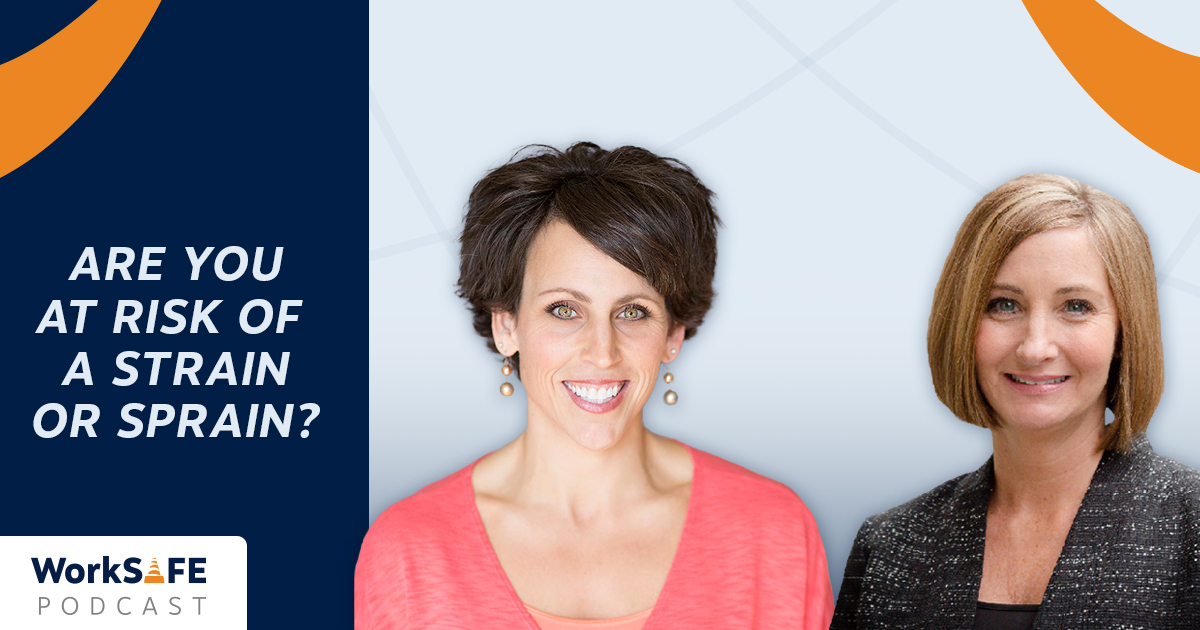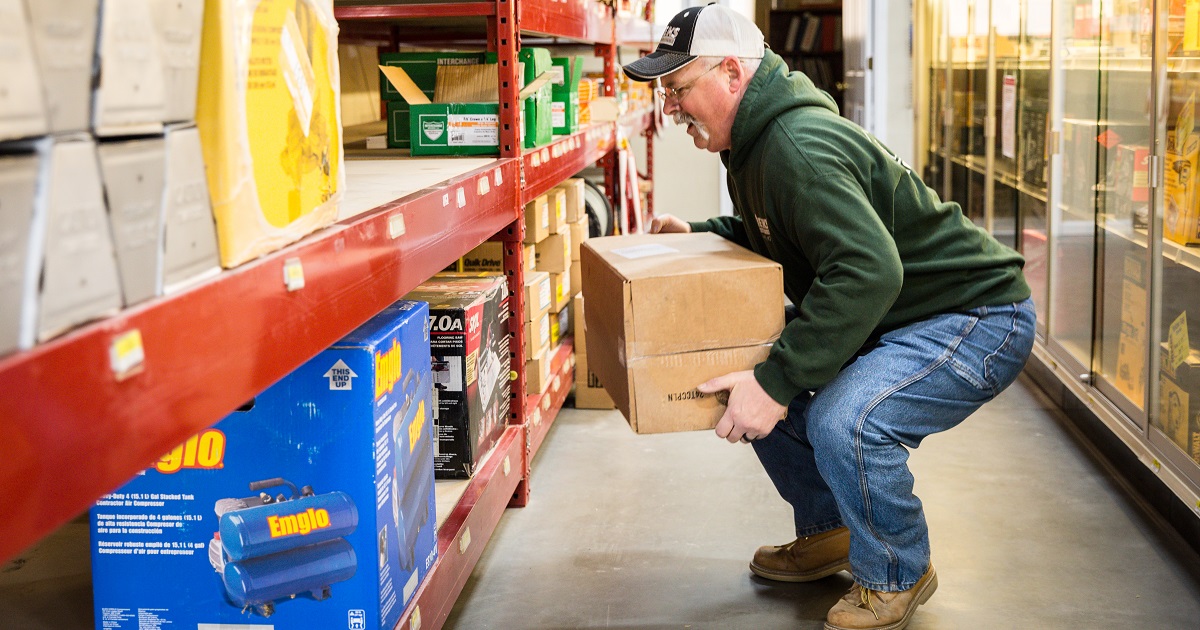Overexertion is the leading cause of workplace injuries. It causes about 34% of lost-time claims. The actions that result in overexertion are simple. Workers in nearly every industry do them daily. However, they can result in strains and sprains.
Strains and sprains can cause continued problems for employees. What kind of tasks lead to these kinds of injuries? How can employers prevent them on the job?
On this episode of the WorkSAFE Podcast, we sit down with Tara Swaney. She is a physical therapist and Work Strategies Coordinator at Select Medical. Swaney has over 20 years of experience. She has worked in outpatient settings and treated injuries in a work comp clinic. Her passion is mentoring clinicians on how to treat work comp injuries, like sprains and strains. She also partners with employers to prevent injuries from happening on the job.

First, we’ll talk about what overexertion injuries are and how they happen. Then, we’ll explain how employers can prevent them. Finally, we’ll talk about rehabilitating strains and sprains.
Listen to this episode on the WorkSAFE Podcast, or read the show notes below.
Strains and sprains: What is an overexertion injury?
Overexertion happens when an employee’s daily tasks are greater than the ability of their body. These tasks can even be a part of their job description. Tired muscles can’t keep up with the work. As a result, damage happens to soft tissue. Strains and sprains happen to ligaments, tendons, and cartilage.
The actions involved seem harmless: lifting a box, reaching for a tool, working on an assembly line. Above all, the risk of overexertion is present in all industries. Some fields, such as healthcare, maintenance, and warehousing, face a higher risk. But even sitting at a computer can result in an overexertion injury.
There are three common types of overexertion injuries:
- Injuries from excessive physical effort. These happen when an employee uses intense force. They can be trying to lift, pull, or throw an object.
- Injuries from repetitive motion. These happen when an employee does the same task every day, often for years.
- Injuries from free bodily motion. These happen when employees do everyday motions with the wrong form or too suddenly. Twisting or kneeling too quickly are common ways to get hurt.
Does overexertion only happen on the job?
“Overexertion is basically just overexerting force with a muscle strain or a ligament sprain. It’s a repetitive use injury,” Swaney explained. Pulling, pushing, lifting, and holding all carry the risk of overexertion. These tasks aren’t only found on the job.
Carrying loads of laundry, or even stooping to pick up kids’ shoes, can cause a strain or sprain. Swaney added that lifting just 35 pounds every day can increase your risk of injury. Many people carry this kind of weight without realizing it. Picking up children, a load of groceries, or front door deliveries are daily tasks for most. “If you’re lifting incorrectly, you’re going to develop an injury sooner rather than later.”

How can employers prevent strains and sprains?
For Swaney, there are several actions employers can take to prevent strains and sprains. They include:
- Educate. Teach employees how to lift properly. Unsafe lifting can put them at serious risk for a back injury.
- Form a safety committee. Employees should receive regular safety education. In addition, sharing the responsibility for it helps keep them accountable.
- Create a stretching program. Swaney encourages employers to create a stretching program. First, a physical therapist assesses employees while they work. Then, they recommend several exercises to help keep employees safe and fit. Finally, a few employees are chosen to lead others in those stretches each day.
- Do ergonomic assessments. Make sure work areas are set up for success. For example, are tools easy to reach? Are desks tall enough to stand or sit at? Learn how you can make your work space a better fit for employees.
What if a strain or sprain happens on the job?
Being proactive is key to preventing strains and sprains. However, they do still happen on the job. Older employees are even more at risk. If your employee gets a strain or sprain, then it is important to act quickly. Swaney recommends using the RICE method. It can help reduce the impact of a strain or sprain.
- Rest. When a strain or sprain happens, rest the injury. This helps avoid causing further damage.
- Ice. Put a cold compress on the area. This eases pain. In addition, it can also help reduce swelling.
- Compress. Wrap the injury in an elastic bandage. Make sure not to wrap it too tightly. That can affect blood flow.
- Elevate. Raise the injured area to reduce further swelling.
Early symptom intervention programs
Select Medical partners with employers to tackle injuries early. This is done through an early symptom intervention program. First aid is applied to a strain or sprain. Workers receive ice, heat, massage, and tape. They are also educated on how to prevent further injury. The program prevents simple strains and sprain from getting worse.
Stretches are a great way to provide relief. If an employer has a stretching program, then stretches can be added to the first aid routine. However, if they don’t, the stretches are considered treatment. The stretches are then only given after the injury is reported.
Above all, the program is an intervention. Select Medical limits employees to 3-4 visits. If there are no improvements, they arrange further medical care.
Surgical intervention for strains and sprains
Some strains and sprains need surgical intervention. For example, employees sometimes suffer in silence. They don’t speak up about sore backs or knees. As a result, the injury gets worse over time. Others simply run out of treatment options.
Select Medical communicates directly with claims adjusters. If an employee isn’t getting better, then they continue to work with them until surgery can be scheduled. “Even if someone has an injury where surgical intervention is required, they can still do range of motion exercises,” Swaney explained. “They can still do some sort of strengthening.”

Support employees at home and work
COVID-19 changes the way work looks in many industries. Strains and sprains are still a risk at home and at work. Employees spend more of the day sitting. They are at increased risk for neck and back pain. Make sure your employees have what they need to be successful.
Encourage them to set up an ergonomically correct work station. Stress the importance of rest breaks. Simple stretches help keep the body relaxed. If your employees are spending a lot of time in front of screens, then share tips for computer users. Whether at home or at work, employers can help prevent overexertion injuries.
Want to learn more about preventing overexertion injuries? Listen to our interview with Doug Davis, a licensed professional engineer specializing in workplace safety and team member, on the WorkSAFE Podcast. Then, check out free safety policies, posters, and starter kits at our Resource Library.